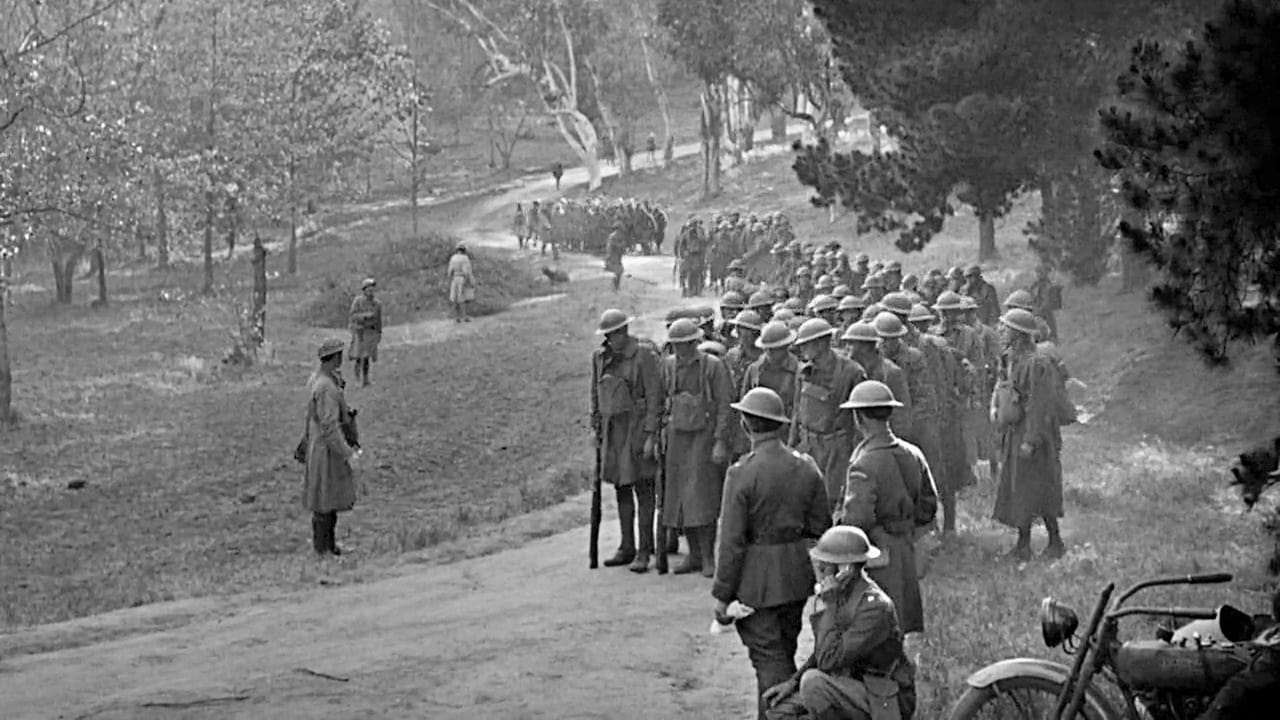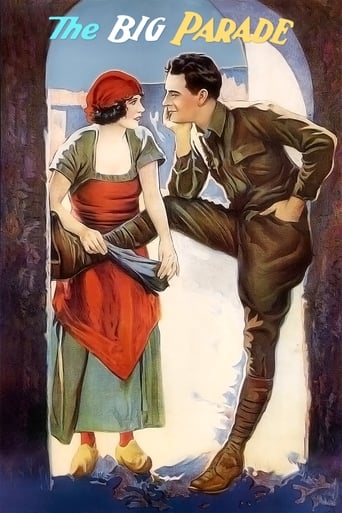

John Gilbert (a favorite of mine) is so funny, tragic, and REAL in this film. I really felt for his character (Jimmy). The first night he's away from his comfortable home, I could see the loneliness and longing in his face. The battle scenes were extraordinary - the musical score really captured the chaos and destruction of war. The scenes with the fireworks and explosions with all those men dying were breathtaking and heart wrenching. My favorite scene is when Gilbert is hitting on the French girl by the creek and he keeps stroking his finger up and down her arm and trying to kiss her. He's so nonchalant about it as if it came naturally and was improvised. I found myself smiling and softly laughing at the tender scene. That's really fine acting when a performer can make a small scene stand out like that. To me it is more memorable than the highly dramatic scene when Jimmy is out on the battlefield screaming that the Germans have killed his friend and sets out to kill the enemy - still a wonderfully acted scene, but the former just help to enforce my opinion of Gilbert as one of the finest actors ever to grace the silver screen.One scene that tugs at my heart is when Jimmy returns home and sees his mother for the first time on crutches, minus his leg. Didn't you get tense too, as the young doughboys make the march through that field with all the snipers in the trees? I also like the scene where he gives gum to Renee Adoree and she's never chewed it before. Very cute! She was another who couldn't survive the transition to sound, not because of her voice, but because of tuberculosis with which she was diagnosed in 1930. She didn't follow doctor's orders and died of the disease in 1933.Highly recommended. It's one of the only silent films that Warner Brothers has bothered to press rather than burn to DVD in the post-DVD era, and I am grateful for that.
... View MoreHaving canvassed the majority of extant films from the silent era, I have a basis of comparison in evaluating this 1925 film in which one John Gilbert proved beyond any doubt that his dramatic capabilities extended beyond matinée idol and the "Great Lover" tag that he so abhorred up until his untimely death of consumption at 36. Gilbert was leading man for none other than Greta Garbo, Lillian Gish, and Mary Pickford- a feat no other actor could boast, and indicative of the span of his career. Here he is the spoiled rich kid who volunteers for infantry and combat duty. It was a theme that Oliver Stone would draw from his own experience decades later in writing Charlie Sheen's character in Platoon. Here he is torn between a fiancée back home and an absolutely endearing French girl played with unbelievable subtlety and naturalness by Renee Adoree. Gilbert and co-stars Adoree and Karl Dane all died tragic deaths within just a few years of this outstanding film. Gilbert essentially drank himself to death, Adoree died of tuberculosis in 1933, and Dane committed suicide when the talkie era 86d his illustrious silent film career. We have them all under the careful direction of the best director of all time King Vidor. To my knowledge, over his 60+ year career in Hollywood, Vidor made not a single flop, not one film that isn't critically acclaimed. Among his arsenal- The Crowd, Show People, Ben Hur, The Jack-knife Man, La Boheme. So here I go with my bold declaration.... The Big Parade is King's finest hour. It is cleverly paced, the editing is flawless, the acting is so natural you'd think you were watching real events as they unfold. The musical score by Carl Davis is the best he has ever conjured, and that's saying an awful lot. THE BIG PARADE. Yes. Get it, turn the lights out, clear the mind, and ready yourself for the film experience of a lifetime.
... View MoreTHE BIG PARADE was written by Laurence Stallings, a veteran of World War I. In his autobiography, director King Vidor wrote that he was tired of laboring for months on a feature only to see it play for one week in theaters. So in 1924 he asked M-G-M's head of production, Irving Thalberg for the opportunity to make a "serious" picture that would have legs. Thalberg was convinced that good art and good box office were not necessarily incompatible and the men began to search for an appropriate war story. When Stallings' play WHAT PRICE GLORY? caught Thalberg's attention, the writer was hired.THE BIG PARADE was first designed as a modest programmer concerning one young man's disillusionment in the face of war. When the MGM executives took a look at the rushes, they gave Vidor the go-ahead to film an all-out "spectacular", which ended up running 13 reels and costing a then-astronomical $382,000. It returned 5 million dollars in the days when tickets averaged less than $.25 each.There had been war films before it but Vidor wanted to capture the human dimension behind war from a grunt's point of view. Like Vidor's other masterpiece THE CROWD it shares his philosophy that we are basically anonymous and anti-heroic our destinies determined by events out of our control.The film opens on three young men from different walks of life: a Bowery bartender, Tom O'Brien as Bull; a gawky ironworker Karl Dane as Slim; and a rich man's son, John Gilbert as James or Jimmy. Where the story differs from wartime propaganda is seen in its careful attention to each individuals humanity.The first half of the film is taken up with the horsing around between the army buddies and a young French woman they meet played by Renee Adoree. Their experiences billeting in France are at first light-hearted. There was even some controversy at the time that lip readers could make out actual curse words actors used and later versions had some shots shortened to prevent offending viewers.Gilbert woos the beautiful village girl who looks just like his fiancé back home. Scenes between Gilbert and Adoree, as he shyly flirts and she shyly retreats, made the most of Gilbert's flair for understated acting.The second half of the film gives way to the shocking reality of the horrors of war.The film's many highlights include: the gum chewing lesson (something Vidor claimed he improvised on the set to add a more human dimension); then there is the famous shot of Adoree not letting go of Gilbert as he and his fellow soldiers march to the front with the endless straight-line of hundreds of trucks suggesting the endless amount of supplies and men, the big parade if you will marching off the end of the world.Vidor prepared himself for the subject by screening documentary films made by the U. S. Army Signal Corps during World War I. When viewing footage of a group of soldiers solemnly escorting a funeral cortege, Vidor was inspired to choreograph the filming of the American forces' march through Belleau Wood to the beat of a metronome amplified by a bass drum to heighten the sense of foreboding and death.Sound was used to emotional effect during the film's remarkably successful 2 year run (a little longer than the usual one week run) at New York's Astor Theatre on Broadway, where eighteen men with bugles and wagons filled with iron created sound effects to replicate the experience of actual battle.New York Times placed The Big Parade at the top of its list of best films for 1925, praising it as "the top-notch photoplay of the year" and "unusually original in detail." The Variety review called it "the best of the war pictures" and praised John Gilbert's performance as "superb" and a "triumph for director King Vidor." War films today are usually copies of earlier films influenced by this original, I invite you to see it through those innocent eyes. As if you had never seen a war film and had just walked into a theater in 1925 . . .
... View MoreBig Parade, The (1925)**** (out of 4) One of the all-time great war movies made John Gilbert a star and rightfully so. In the film he plays a spoiled rich kid who joins the Army on a whim after WW1 starts. He gets shipped off to France where he meets two guys who will become his best friend but also a woman (Renee Adoree) who he will fall in love with before being sent to the front lines. This is yet another classic film that really delivers on its reputation and in my opinion it's even better than the actual reputation. This is known for being a great war film but I'd go a bit further and say it's easily one of the best films of the decade and one of the strongest anti-war films ever made. I've heard a few people say that the love story is too melodramatic but I'd disagree with that as Vidor really handles the material very well and I'm sure there were millions of women in 1925 who would disagree about the love story. I think Gilbert and Adoree are so great together that we can easily buy them together and buy their story together. I must admit that I really got caught up in their relationship and all the drama that went with it. Yes, it's fairly predictable but it's still effective and that's all that matters. The film has several unforgettable shots even before we get to the legendary battle scene but the one with Adoree trying to say goodbye is extremely powerful. As for the battle scene that lasts for nearly a half-hour; pure brilliance. This is where the film lives up to its reputation and more because this entire sequence is known to be great but I'd probably push it a bit further and say it's one of the greatest ever created. It's also a great example of why silent movies can be so effective because not hearing the gunshots, the explosions and the screams really makes the sequence all the more surreal and Hell-like. Vidor does a masterful job at building this sequence up over time and I loved the way how it started so small with the simple walk and then built up the human drama before going all out with the battle. The final moments of the battle scenes are incredibly effective and a real treat on the eyes. I sometimes have a problem with war movies that want to show off the "battle" yet preach that it's wrong but this film manages to get the message across with a lot of power. It's also easy to see why Gilbert became a star after this film because his character goes through a lot of changes throughout the film and he handles all of them perfectly and in the end you can't help but think you've witnessed a true character and changes. This film is certainly one of the best war movies out there but it also features a lot more than just battle scenes and in the end it's certainly one of the highlights of silent cinema.
... View More